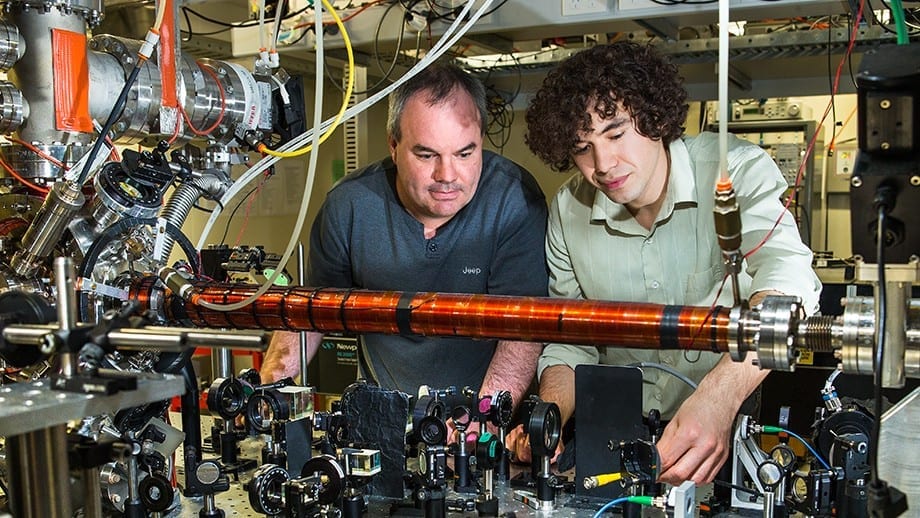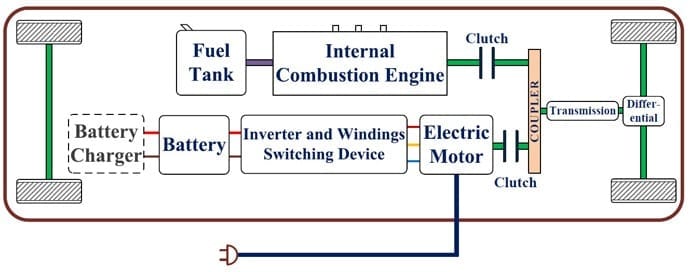Professor Weimin Chen and his colleagues at Linköping University, in cooperation with German and American researchers, have succeeded in both initializing and reading nuclear spins, relevant to qubits for quantum computers, at room temperature.
A quantum computer is controlled by the laws of quantum physics; it promises to perform complicated calculations, or search large amounts of data, at a speed that exceeds by far those that today’s fastest supercomputers are capable of.
“You could say that a quantum computer can think several thoughts simultaneously, while a traditional computer thinks one thought at a time,” says Weimin Chen, professor in the Division of Functional Electronic Materials at the Department of Physics, Chemistry and Biology at LiU, and one of the main authors of the article in Nature Communications.
A traditional computer stores, processes and sends all information in the form of bits, which can have a value of 1 or 0. But in the world of quantum physics, at the nano- and atomic level, other rules prevail and a bit in a quantum computer – a qubit – can have any value between 1 and 0. A spin-based qubit makes use of the fact that electrons and atomic nuclei rotate around their own axes – they have a spin. They can rotate both clockwise and counterclockwise (equivalent to 1 and 0), and in both directions simultaneously (a mix of 1 and 0) – something that is completely unthinkable in the traditional, “classical” world.
An atomic nucleus consists of both protons and neutrons, and the advantage of using the nuclear spin as a qubit is that the nucleus is well protected, and nearly impervious to unwanted electromagnetic disturbance, which is a condition for keeping the sensitive information in the qubit intact.
The first step in building a quantum computer is to assign each qubit a well-defined value, either 1 or 0. Starting, or initiating, the spin-based qubits then requires all the atomic nuclei to spin in the same direction, either ‘up’ or ‘down’ (clockwise or counterclockwise). The most common method for polarising nuclear spin is called dynamic nuclear polarisation; this means that the electrons’ spin simply influences the nucleus to spin in the same direction. The method requires strongly spin polarised electrons and functions superbly at lower temperatures. Dynamic nuclear polarisation via conduction electrons has, however, not yet been demonstrated at room temperature – which is crucial for the method to be useful in practice for the development of quantum computers. The main problem is that the spin orientation in the electrons can easily be lost at room temperature, since it is sensitive to disruptions from its surroundings.
Linköping University researchers Yuttapoom Puttisong, Xingjun Wang, Irina Buyanova and Weimin Chen, together with their German and American colleagues, have now discovered a way of getting around this problem.
The Latest Bing News on:
Quantum computer
- Scientists uncover quantum-inspired vulnerabilities in neural networkson May 9, 2024 at 1:51 pm
In a recent study merging the fields of quantum physics and computer science, Dr. Jun-Jie Zhang and Prof. Deyu Meng have explored the vulnerabilities of neural networks through the lens of the ...
- Researchers develop compiler acceleration technology for quantum computerson May 9, 2024 at 1:47 pm
Researchers have succeeded in developing a technique to quickly search for the optimal quantum gate sequence for a quantum computer using a probabilistic method.
- NATO and quantum computing are part of the cybersecurity agenda for IBM Consultingon May 8, 2024 at 5:50 pm
IBM collaborates with NATO to fortify cybersecurity. Enhancing security visibility management across NATO networks, IBM builds a customized solution.
- Quantum Computing Revolutionizes Energy, Agriculture, and Material Scienceon May 8, 2024 at 9:01 am
Quantum computing provides more novel and reliable ways to accelerate progress in mitigating climate change and does so faster than other known technologies. For instance, it can execute optimization ...
- Physicists Develop Groundbreaking Device for Advanced Quantum Computingon May 8, 2024 at 4:16 am
Researchers have made a significant advancement in quantum computing by adapting a microwave circulator to precisely control the nonreciprocity between a qubit and a resonant cavity. This innovation n ...
- The Future Of Climate Could Be In Quantum Computingon May 7, 2024 at 7:43 am
Quantum computing has a number of advantages over other technologies in terms of accelerating our progress with reducing climate change.
- 'World's purest silicon' could lead to 1st million-qubit quantum computing chipson May 7, 2024 at 2:00 am
Scientists engineer the 'purest ever silicon' to build reliable qubits that can be manufactured to the size of a pinhead on a chip and power million-qubit quantum computers in the future.
- New super-pure silicon chip opens path to powerful quantum computerson May 7, 2024 at 2:00 am
Researchers at the Universities of Melbourne and Manchester have invented a breakthrough technique for manufacturing highly purified silicon that brings powerful quantum computers a big step closer.
- How Schrödinger's cat could make quantum computers work betteron May 6, 2024 at 8:00 am
A quantum bit inspired by Schrödinger’s cat can resist making errors for an unprecedentedly long time, which makes it a candidate for building less error-prone quantum computers ...
- Pritzker eyes a $20 billion quantum-computing campuson May 6, 2024 at 3:31 am
PsiQuantum would be the anchor of much larger project that Illinois hopes will make it the center of this next-generation computing technology.
The Latest Google Headlines on:
Quantum computer
[google_news title=”” keyword=”quantum computer” num_posts=”10″ blurb_length=”0″ show_thumb=”left”]
The Latest Bing News on:
Quantum Computing
- Quantum breakthrough sheds light on perplexing high-temperature superconductorson May 9, 2024 at 12:06 pm
Superfast levitating trains, long-range lossless power transmission, faster MRI machines—all these fantastical technological advances could be in our grasp if we could just make a material that transmits electricity without resistance—or "superconducts"—at around room temperature.
- Opinion: The quantum computing race is onon May 5, 2024 at 6:00 am
A lthough scientists don’t completely understand the underlying science of quantum mechanics, a global geopolitical, military and commercial race is on for the development of affordable and reliable quantum computers and associated software. How long it will take and how much it will cost is far from clear.
The Latest Google Headlines on:
Quantum Computing
[google_news title=”” keyword=”Quantum Computing” num_posts=”10″ blurb_length=”0″ show_thumb=”left”]











